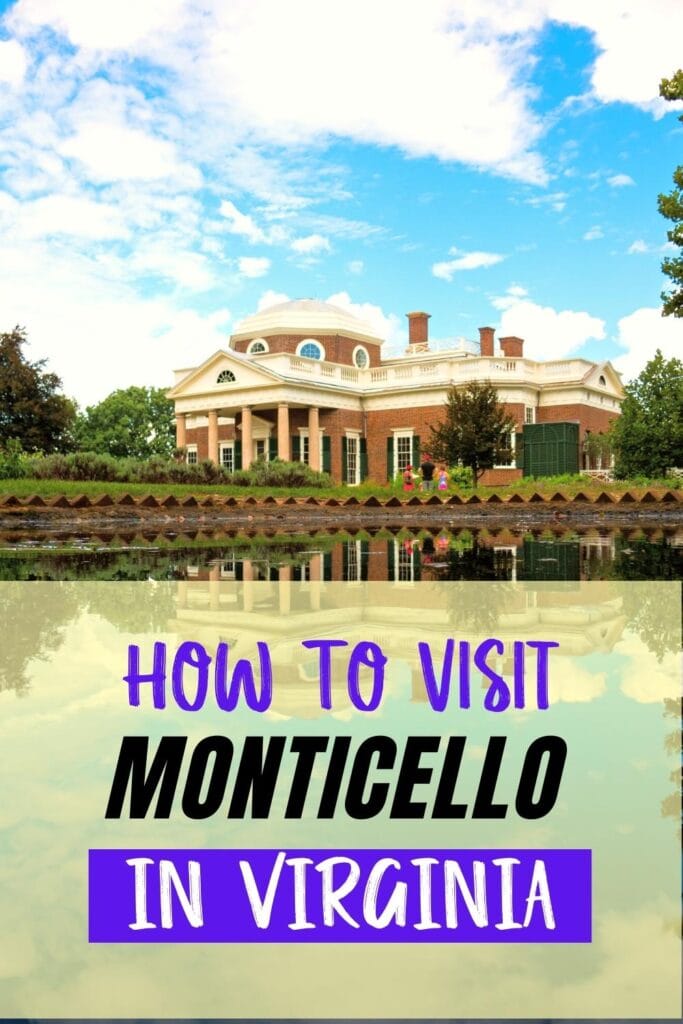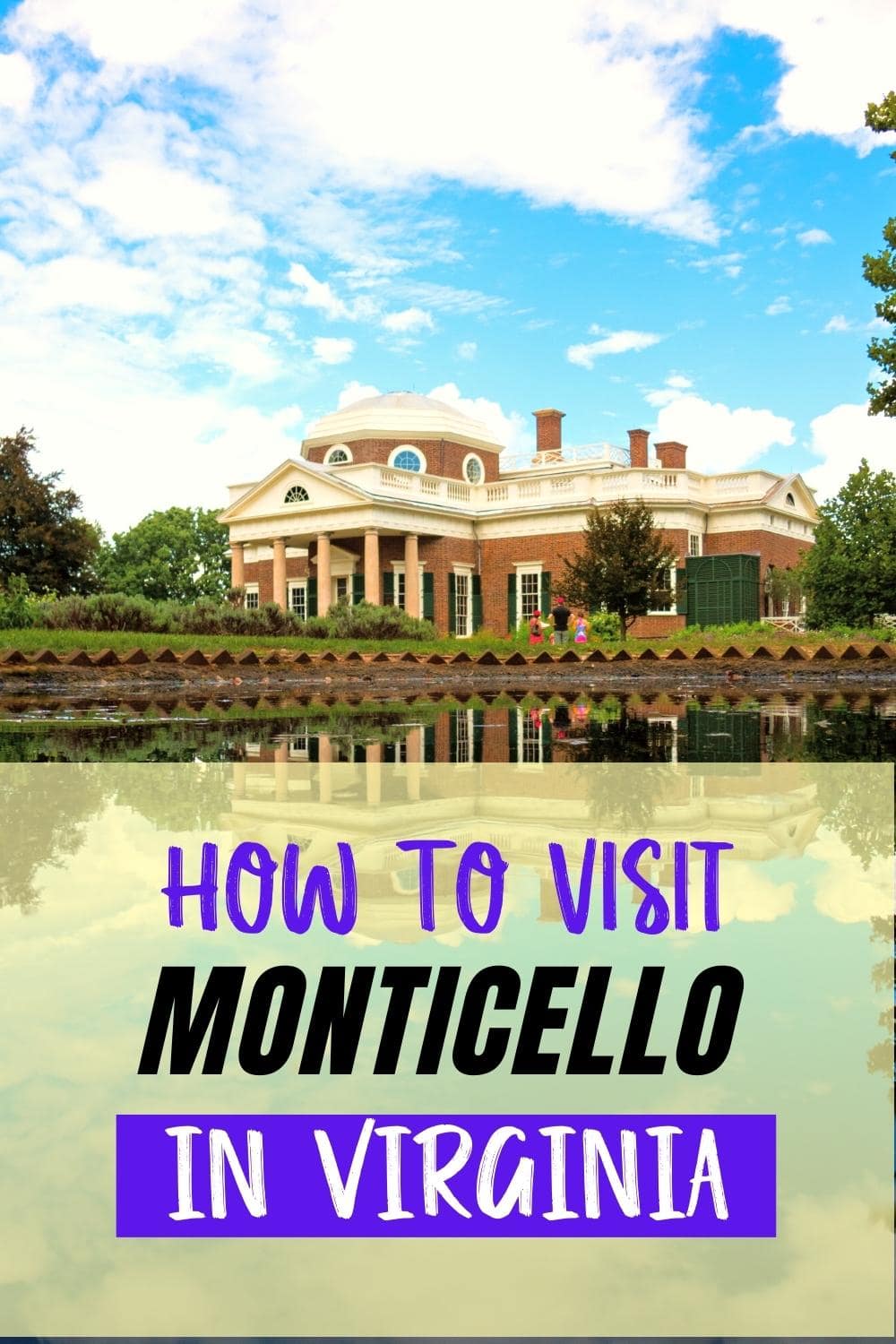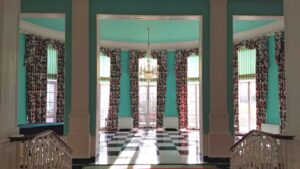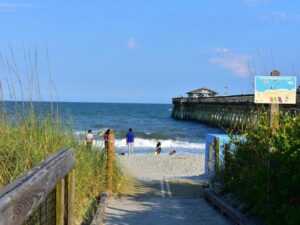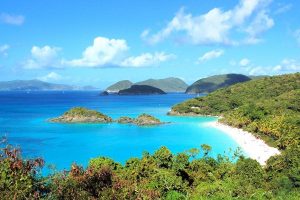Visiting Monticello is an easy day trip from Charlottesville, VA and worth the time for a peek into the home of one of America’s most influential founders: Thomas Jefferson.
Come tour the home that he designed and renovated, see the plants that he cultivated, and see the plantation that supported him financially while he made his mark on history.
This post may contain affiliate links. As an Amazon Associate and associate of other programs, I earn from qualifying purchases. This means if you click a link and make a purchase, I may earn a small commission at no extra cost to you.
Visiting Monticello: What to Expect
The main attraction at Monticello is Thomas Jefferson’s house, a National Historic Landmark as well as a UNESCO World Heritage Site.
Thomas Jefferson is undeniably one of America’s most influential founding fathers, and his home in Virginia reflects all of those achievements.
Monticello’s exterior is heavily influenced by Italian and French architecture, the latter of which he picked up when serving as Ambassador to France.
His front entry was decorated floor to ceiling with scientific specimens collected by Lewis and Clark as they explored the lands bought through President Jefferson’s Louisiana Purchase.
The south wing holds Jefferson’s third library collection. (His first library burned in a fire and his second was sold to the government to start the Library of Congress.)
He was gifted the land by his father, and Thomas would spend the rest of his life alternating between serving in public offices elsewhere and enjoying spending time at home in Virginia.
You’ll see his inventions, scientific specimens, gardens, books, clothes, and even his grave on the grounds of Monticello.
But there’s more to the “little mountain” than just that side of the story.
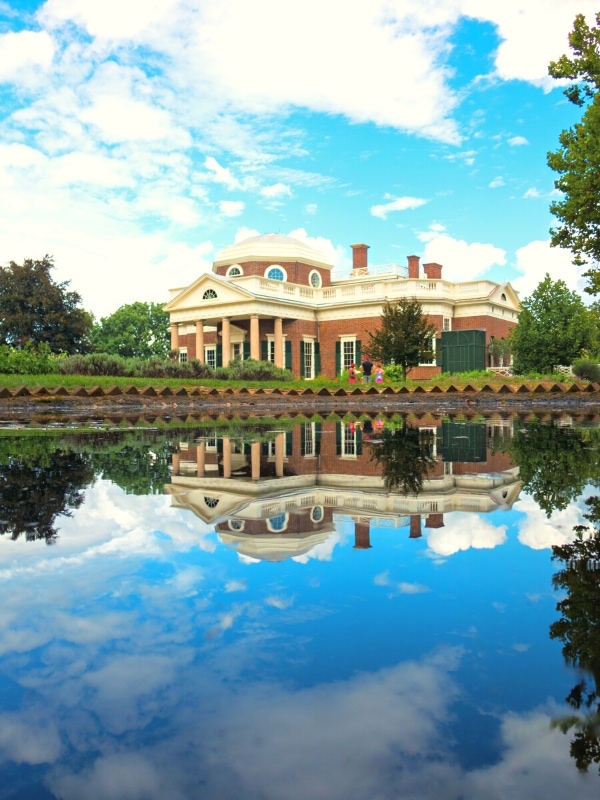
Addressing the Past
Monticello was a plantation and functioned at the expense of enslaved lives.
Like most plantations-turned-historic sites open to the public, Monticello has done better in recent years to address slavery and bring to light important, if unsavory, details.
Tours and exhibits provide the history and context for what life was like for the enslaved that lived and worked at Monticello.
An important addition, however, is a tour dedicated to telling Sally Hemings’ story.
Sally was a house slave at Monticello and had at least six children, all fathered by Thomas Jefferson.
That scandalous rumor had been debated since Jefferson’s lifetime, first introduced by a political rival, but was finally semi-put to rest with DNA testing done in 1998.
It proved a shared Y chromosome linking a Jefferson male to Sally Hemings’ children.
The most likely candidate, who was at Monticello at the time of conception for all of Sally’s kids, is Thomas Jefferson.
We won’t get into all the details and conjecture here, but here’s a very detailed book if you’re interested.
Touring Monticello: Which Tour is Best?
Which Monticello tour is best is dependent on who you’re traveling with and what you want to see or learn while you’re visiting.
>> If you prefer the freedom of self-guided tours and can walk through a space without a guide or exhibit plaques explaining what you’re seeing, then choose the Self-Guided Pass.
>> If you prefer a little more information about what you’re looking at, then choose the guided Highlights Tour.
>> If you want to see the upper floors of the house including the famous Dome Room, then you need the Behind-the-Scenes Day Pass.
>> If you’re traveling with little kids, opt instead for the Gardens and Grounds Pass with no house entry.
>> If you have kids ages 5-11, then choose the guided Family-Friendly Tour which shows off things in the house that kids find cool.
No matter which pass you purchase, two 45-minute guided tours are included with admission: Slavery at Monticello and the Gardens and Grounds Tour.
They don’t require reservations; just show up at one of the three posted times and listen to the presentation. You can join both or neither.
Good to Know: Lately, the tour options offered at Monticello have been changing frequently. We recommend you check the website and reserve your tickets ahead of your trip.
What to Do at Monticello
Here we’re giving a little more information on all the things you can see and do at Monticello so you can make a better choice for which ticket to purchase.
There’s a lot here, so if you want to do it all, plan to spend an entire day at Monticello.
Exhibits and tours are divided between two areas: the visitor center and the mountaintop.
Which you tackle first depends on your house timed entry ticket and when you arrive at Monticello.
Complimentary shuttle buses whisk you up the mountain, if you don’t want to walk up.
The David Rubenstein Visitor Center
Your visit to Monticello begins at the Visitor Center complex. You’ll pass through security screening and get your tickets here if you didn’t buy ahead online.
Several exhibits introduce you to Thomas Jefferson, his accomplishments, and his life at Monticello.
Check out the short, 7-minute introductory film.
Then, enjoy exhibits about writing the Declaration of Independence, designing Monticello’s architecture, and creating Jefferson’s inventions.
The Griffin Discovery Room is a must-see for kids. It makes learning about Jefferson fun and interesting on a level appropriate for children.
The visitor center complex also has a small café with pre-made lunch items and drinks.
A large gift shop is worth a stop to find Jefferson souvenirs and products made from things grown on the farm.
Inside the House
Tour the iconic home of America’s third president, filled with his books, effects, and inventions.
It’s almost as if he’s just stepped out for a minute while you get an inside look into how he lived.
Jefferson was a life-long scholar and inventor, and his home was no exception. He designed the home and renovated and expanded it several times.
He added several inventions of his own, like his letter copy maker in his study.
He also showcased stuffed animals and plants in the front entry that Lewis and Clark brought back from their expedition.
Touring the second floor requires a separate ticket but gives you a closer look at the iconic rotunda.
Its design was meant to collect hot air and expel it out the top, as close as you get to air conditioning in the colonial era.
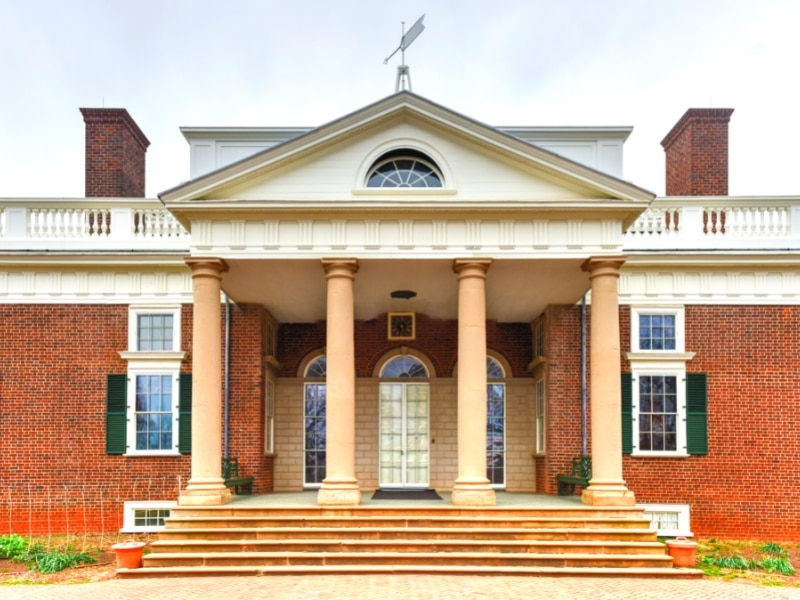
Outside and Under the House
The wings of the house and the all-weather passage under the house are open for self-guided exploration.
The South Wing features domestic exhibits like the kitchen, dairy, and smokehouse as well as an exhibit on the life of Sally Hemings, a must-see.
The South Pavilion is also where Thomas lived with his wife, Martha, when they first married while he was still renovating the house.
The North Wing examines conveniences in Jefferson’s time.
Exhibits discuss his love and need to travel, the ice house for fresh meat and cold wine, and the innovative use of indoor privies (bathrooms) which was highly unusual for his time.
Mulberry Row
Stroll along this shaded path and stop in at each exhibit to see how the enslaved men, women, and children lived at Monticello.
Mulberry Row was like the beating heart of the plantation.
Most of the industrial aspects of the plantation stood here, like the nailery, textile shop, and blacksmith shop.
A few slave quarters were also built on this street, including a reconstruction of enslaved John and Priscilla Hemmings’ cabin.
John was a carpenter and Priscilla was a nursemaid to Jefferson’s daughter Martha’s children.
Meet Thomas Jefferson
Come meet Thomas Jefferson in person!
Or rather, come meet historical actor Bill Barker portraying Thomas Jefferson. He’s very good!
There’s a 20 minute talk where Thomas introduces himself and chats with the group about life during his timeline.
Don’t worry; it’s not a boring history lecture. You’ll laugh.
Then, he steps off to the side and you can take pictures with him. Proof that you met Thomas Jefferson!
No reservations required. Included with admission, no matter which pass/ticket you buy.
Check the schedule before you arrive. Usually available Tuesday through Saturday.
The Gardens & Grounds
Jefferson liked to experiment with plants, and, of course, Monticello was a self-sustaining farm, growing crops to sell and to feed the estate.
All of the plants in the garden and the vegetable patch today are from specimens Jefferson worked with while he lived at Monticello.
He liked ornamental plants from other parts of the world, but he also liked to try to improve on “useful” plants.
The best way to learn about the many plants and their history at Monticello is to take the included Gardens and Ground Tour.
Otherwise, you’re just enjoying the beauty without knowing what you’re looking at.
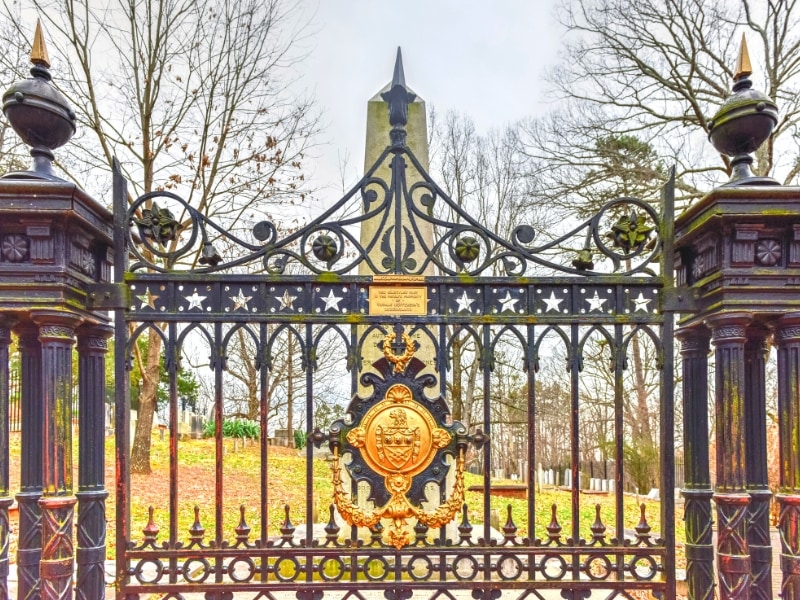
The Monticello Cemetery
A short walk down the hill from the gardens, you’ll find the Monticello Cemetery which houses the Jefferson family plot.
(If you don’t want to walk, the shuttle bus also stops nearby.)
Thomas Jefferson is buried here, per his final wishes, on the slopes of his beloved home.
The epitaph on his grave, which he wrote, doesn’t even mention his tenure as 3rd President of the United States!
The cemetery is still owned and used by the Jefferson family descendants, so you aren’t allowed inside.
But you can get some good pictures and see Jefferson’s grave from the ornamental fence that surrounds it.
The Burial Ground for Enslaved People
Many years after Monticello was converted into a historical site and opened to the public, a slave cemetery was discovered in the middle of the visitor center parking area.
Burial sites for slaves can be difficult to find as they often were buried without durable markers.
Think handmade wooden crosses rather than cut stone monuments.
This is the case at Monticello. A few rocks placed at the head and foot of a couple of graves were the only indication that a possible cemetery existed.
Archaeological excavations confirmed the limits of the burial ground so proper separation could be placed without impacting any unknown graves.
In 2022, Monticello completed improvements to the area and rededicated the burial ground in a private ceremony for the descendants.
The Saunders-Monticello Trail
Explore more of the corner of Virginia that Jefferson called home with a beautiful stroll down the Saunders-Monticello Trail.
This trail connects the Monticello Visitor Center parking lot to one of Virginia’s most popular parks, an area full of scenic trails.
Most trails are easy and less than a mile long, but feel free to string several trails together for a longer walk.
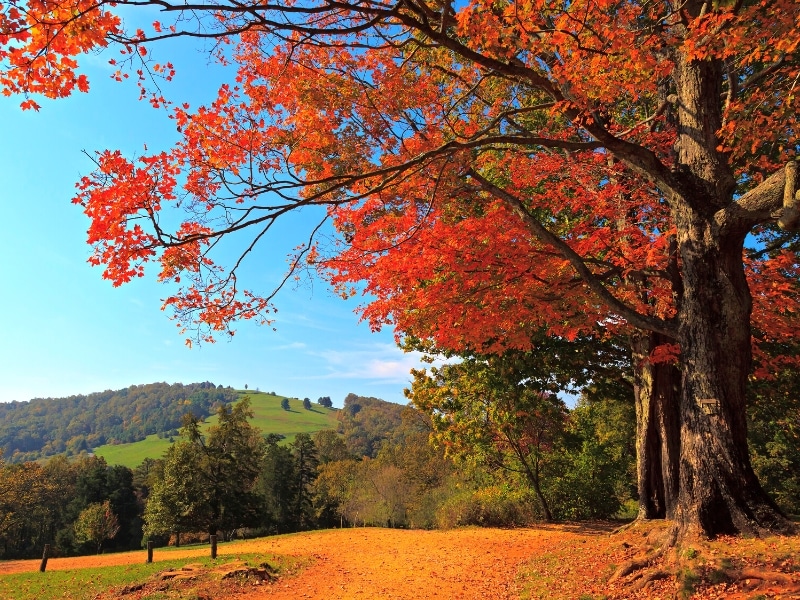
Practical Info & FAQs for Visiting Monticello
>> How Much Does It Cost to Visit Monticello?
Adult tickets range from $22-95 per adult, depending on how much of the house you want to see. Kids aged 11 and under are free. Youths aged 12-18 are usually under $15.
However, the Behind-the-Scenes Tour and the From Slavery to Freedom Tour charge adult admission for all attendees.
If you’re interested in a private guide or VIP tour, those are considerably more and have to be scheduled ahead of time.
>> How Long Do You Need to Visit Monticello?
We recommend a minimum of 2-3 hours to visit Monticello. The fastest guided tour of the house and the two included tours on the grounds will take every minute of that 3 hours.
If it’s your first visit to Monticello, we recommend you spend most of the day and see everything you can.
>> When’s the Best Time of Year to Visit Monticello?
Spring and Fall are equally beautiful and a good time of year to visit Monticello. Spring sees the gardens and forests in bloom without the intense heat of summer. Fall features gorgeous fall colors with a cool nip in the air.
>> Can You See Monticello from the Road?
No, you can’t see Monticello from the road. The house is at the top of the mountain. The road is further down, and the view is obstructed by the forest.
>> Can You Walk around the Grounds at Monticello for Free?
No, you cannot walk around the Monticello grounds for free. You must purchase a Gardens and Grounds Pass to explore the mountaintop up by the house and gardens.
>> Can Kids Go Inside the House at Monticello?
Yes, well-behaved kids are welcome inside the house. If you have a younger child that shouldn’t go inside, talk to the staff. They will let you and an adult partner take turns inside the house while the other stays outside.
>> Are Strollers Allowed Inside the House at Monticello?
Yes, small strollers are allowed inside Monticello or can be borrowed at the front if your stroller is too large.
Enjoy Visiting Monticello!
We’ve enjoyed visiting Monticello every time we’ve gone. There’s always something new to learn or to notice when you explore the house and grounds.
It’s also one of those rare historical spaces that can tailor your visit to a variety of ages and walking abilities.
That’s important when you’re traveling with kids or seniors!
More Virginia Travel Ideas
- Short & Easy Hikes in Shenandoah National Park
- Epic Eastern US Road Trip – See 6 States in 9 Days!
- How to DIY Tour Washington DC Monuments at Night
Happy travels!

About the Author: Rachel Means
With six-figure student loan debt and only 10 PTO days per year, Rachel started traveling the world. A decade later, she’s paid off her loans, changed careers, and been to 36 US states and 14 countries. She’s an expert at planning and budgeting for travel and loves to help others do it, too! Read her full story here.
Share it!
